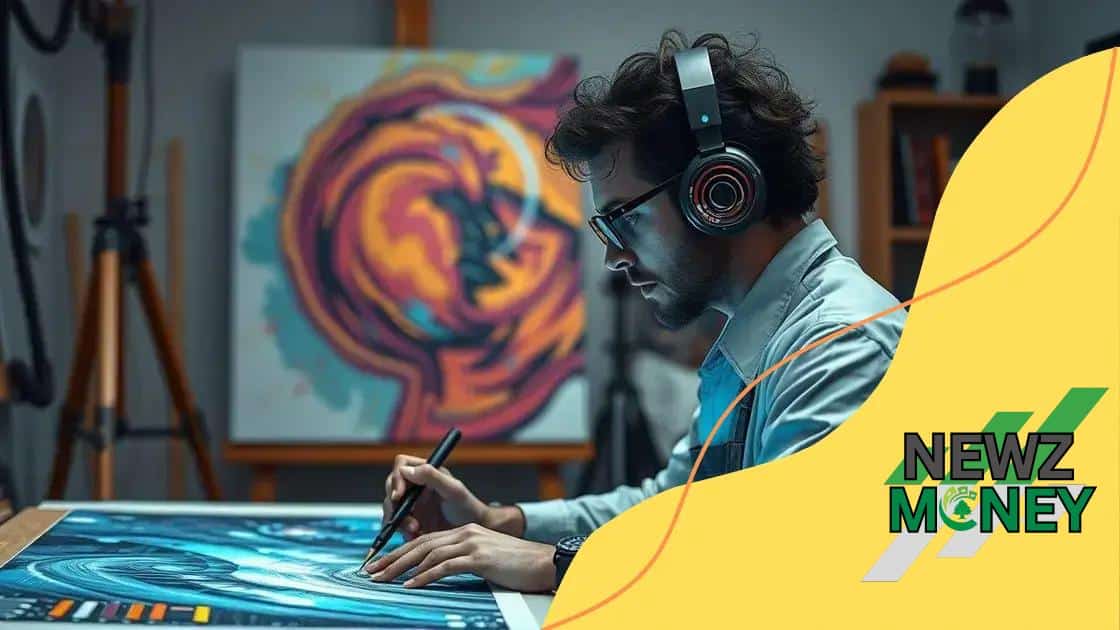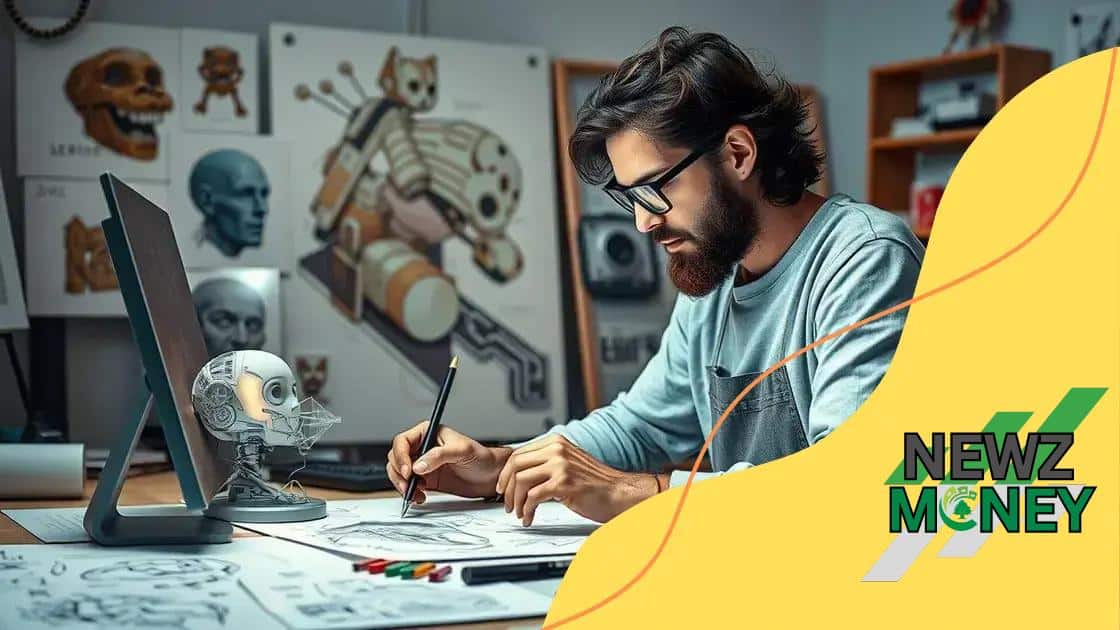The role of AI in transforming the creative industries

The role of AI in transforming the creative industries is significant as it enables artists to enhance their creativity, streamline processes, and explore new artistic expressions through collaboration with machine learning technologies.
The role of AI in transforming the creative industries is more significant than ever, as technology reshapes how we express ourselves. Have you noticed how AI is pushing the boundaries of creativity? Let’s dive into this exciting transformation.
Understanding AI’s influence on creativity
Understanding how AI influences creativity is essential in today’s artistic landscape. From visual arts to writing, AI tools are changing the way creators express their ideas and connect with audiences.
How AI Supports Creatives
AI enhances the creative process through various means:
- Automation of repetitive tasks
- Insights and data-driven inspiration
- New methods of art creation
- Collaboration opportunities
By automating tedious work, AI allows artists to focus on their vision instead. For instance, algorithms can help generate backgrounds or assist in color selection, saving valuable time. This shift empowers creators to experiment more and push boundaries.
AI as a Creative Partner
Many are beginning to see AI not just as a tool but as a creative partner. Programs can suggest ideas or help refine concepts, bringing fresh perspectives to traditional methods. Imagine a writer using an AI assistant that proposes alternative plot lines or a musician experimenting with soundscapes generated by an AI system.
This partnership can spark new projects and styles, encouraging professionals and hobbyists alike to explore uncharted territories. Moreover, collaborations between human and machine can produce unique results that neither could achieve alone.
However, it’s crucial to recognize potential challenges. Questions about originality and ownership amid AI involvement arise, leading to discussions about the ethics of creative work. Will artists lose their voice if machines dictate their art? Addressing these inquiries is vital as we move forward in this evolving space.
AI tools that are revolutionizing the industry
AI tools are fundamentally changing the creative industry. By automating processes and enhancing creativity, these technologies empower artists and creators in exciting ways. With AI’s rapid advancement, it’s crucial to understand the tools available and how they work.
Popular AI Tools for Creatives
Several AI tools stand out for revolutionizing creativity:
- Adobe Sensei: This tool integrates AI into Adobe software, streamlining tasks like photo editing and video production.
- Runway ML: A creative suite that allows artists to use machine learning for video editing and content generation.
- DALL-E: An AI model that produces stunning images from textual descriptions, allowing artists to explore new concepts.
- Jasper: A writing assistant that generates content ideas, helping writers enhance their productivity.
These tools offer features that not only save time but enhance creative possibilities. For instance, with DALL-E, artists can visualize concepts quickly and gain inspiration for their projects.
Benefits of Using AI in Creativity
Working with AI tools provides multiple advantages. They help in:
- Expediting creative workflows
- Providing data-driven insights
- Enhancing collaboration among artists
- Encouraging experimentation with new styles
This blend of technology and creativity helps artists break barriers. For example, a musician might use an AI tool to compose a new piece, exploring sounds they wouldn’t typically consider. This leads to innovation in music, visual arts, and writing.
As these tools develop, artists are challenged to rethink conventions. The integration of AI into creativity raises questions about authenticity and originality. How will these technologies shape the future of artistic expression? Staying informed about AI tools is essential for anyone in the industry.
Case studies of AI in art and design

Case studies illustrate how AI is making waves in art and design, showcasing innovative approaches that redefine creativity. Various artists and designers have started to embrace AI to produce remarkable works.
Proven Impact of AI in Art
One notable example is the use of AI in generating unique artwork. Artists likeref.org/ai-art/ have collaborated with machine learning programs to create pieces that blend human creativity with artificial intelligence. This collaboration leads to fascinating results:
- Unique, never-before-seen visuals
- Exploration of new artistic styles
- Enhanced audience engagement
- The irony of machines creating “human” art
These techniques allow artists to break traditional methods, using AI not just as a tool but as a co-creator. For instance, the work of Mario Klingemann, who employs neural networks, has redefined what art can be, pushing boundaries further.
AI in Design: Real-World Examples
Designers are also leveraging AI to enhance their projects. Companies like Canva and Adobe are integrating AI-driven features to improve user experience. These innovations allow designers to:
- Generate design layouts automatically
- Personalize user experiences
- Optimize images for different platforms
- Streamline feedback and revisions
Such tools not only simplify workflows but also inspire creativity by suggesting new design elements. This hybrid of human and machine ingenuity fosters limitless possibilities. As designers explore these features, they might find insights or solutions that they wouldn’t have arrived at alone.
The blending of AI in art and design is full of potential. Each case study not only shows successful application but also sparks conversations about the future of creativity. How these technologies will evolve further is a topic for ongoing exploration, inviting all creatives to engage with the possibilities.
Potential challenges of AI in creative fields
The integration of AI into the creative fields brings exciting opportunities, but it also poses significant challenges. As artists and designers adopt AI tools, they encounter various hurdles that can impact their work.
Ethical Concerns
One major challenge is the ethical implications of using AI. Questions arise about ownership, especially when AI generates artwork or content. Who owns the rights to pieces created by machines? Additionally, the potential for AI to replicate styles raises issues around plagiarism and originality.
Impact on Employment
Another concern is the impact of AI on jobs within creative industries. As tools become more sophisticated, many fear that human creativity may be undervalued or replaced. In certain areas, automation could lead to job losses, particularly for entry-level positions.
However, while AI can handle tasks like data analysis and repetitive work, the unique spark of human creativity remains irreplaceable. It’s essential for workers to adapt and develop new skills in collaboration with AI.
Quality Control
Quality control also poses a challenge. While AI can produce impressive results, it may not always meet the specific standards or vision of a creator. This inconsistency can lead to frustration and require additional time for human refinement. Artists may need to balance between relying on AI and ensuring that the final product aligns with their intentions.
As the relationship between AI and creativity evolves, understanding these challenges is crucial. By being aware of the potential drawbacks, artists can navigate the landscape of AI in their fields while maximizing its benefits.
The future of creativity with AI
The future of creativity with AI is a topic that sparks excitement and curiosity. As technology continues to evolve, artists and creators are finding new ways to collaborate with AI. This partnership is shaping how ideas are generated and realized.
Emerging Technologies and Their Impact
New technologies are constantly emerging. Tools like machine learning and deep learning provide unique capabilities that artists can leverage. For example, programs that can analyze trends and suggest creative directions are becoming more common. These technologies help in:
- Identifying patterns in art and design
- Generating innovative ideas and solutions
- Enhancing personalization for audiences
- Support in marketing and outreach efforts
With these advancements, artists can create more targeted work that resonates with their audience, expanding the role of creativity in the digital age.
Collaboration Between Humans and Machines
A significant aspect of the future of creativity is the collaboration between humans and machines. Artists are using AI to handle repetitive tasks, allowing them to focus on the more nuanced aspects of their craft. This shift leads to a more efficient creative process.
For instance, a graphic designer might use AI to generate various layout options quickly, then make artistic choices based on those suggestions. This collaborative spirit opens new doors for experimentation and creativity.
Redefining Artistic Expression
As AI evolves, so does the definition of artistic expression. Artists may begin to explore concepts that merge human intuition with machine logic. The lines between artist and tool will blur, leading to questions about authorship and originality.
Moreover, the inclusivity that AI tools provide allows a wider range of voices to enter the creative sphere. New creators can harness these technologies without needing extensive training, broadening participation in the arts.
Undoubtedly, the future of creativity with AI is full of potential. As collaboration, innovation, and inclusion continue to grow, the creative landscape will evolve in ways we are only beginning to understand.
In conclusion, the future of creativity with AI is bright and full of possibilities. As technology evolves, artists and creators can work alongside AI tools to enhance their artistic expression. This collaboration opens new doors for innovation and creativity, allowing for unique forms of art that blend human imagination with machine learning. While challenges like ethics and job security remain important discussions, the overall potential for growth in the creative fields is immense. Embracing these changes will enable creators to explore uncharted territories and redefine what it means to be an artist in the digital age.
FAQ – Frequently Asked Questions about AI in Creative Industries
How is AI changing the creative process?
AI enhances creativity by automating repetitive tasks, allowing artists to focus on their imagination and innovative ideas.
What are some popular AI tools for artists?
Popular AI tools include Adobe Sensei, Runway ML, and DALL-E, which assist in tasks like design generation and art creation.
What ethical concerns arise with AI in art?
Ethical concerns include questions of ownership and originality, particularly when AI generates content or replicates artistic styles.
Will AI replace human artists?
While AI can assist and enhance the creative process, it doesn’t replace the unique human touch and intuition that artists bring to their work.





